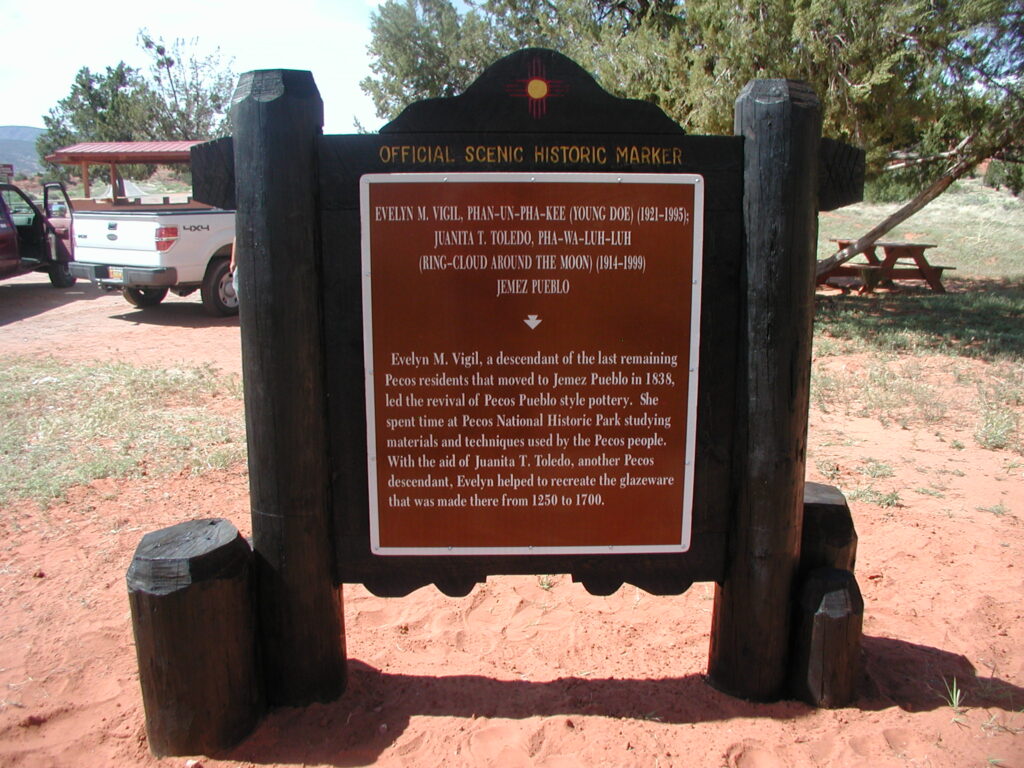Evelyn M. Vigil, Phan-un-pha-kee, “Young Doe” historic marker.
Photo Credit: Courtesy of New Mexico Historic Women Marker Program.
Evelyn M. Vigil, Phan-Un-Pha-Kee (Young Doe)
1921 - 1995
Sandoval County
Pairing Jemez knowledge of pottery making with research conducted by park workers, two women experimented with natural pigments, firing techniques, fuels, and local clays, and ultimately achieved their goal: Successful recreation of the lost art of Pecos style pottery.
In 1583, approximately two thousand people lived in the Pecos Pueblo, one of the most heavily populated pueblos. By 1838, disease and raids had drastically reduced the population. The last remaining seventeen Pecos residents packed up their belongings and relocated eighty miles west to Jemez Pueblo, the only other Towa-speaking community. They assimilated into the Jemez culture, and in the process lost their distinct ceramic tradition.
The mission and dwellings at Pecos survived, came under the care of the National Park Service, and were designated a National Historical Park in 1965. In the 1970s, personnel affiliated with the park initiated a program to rediscover the pottery tradition of Pecos Pueblo. Two Pecos descendents, Evelyn M. Vigil and Juanita T. Toledo, helped uncover details of this lost craft. The women have been compared to two other notable Pueblo potters, Maria and Julian Martinez of San Ildefonso Pueblo, for their successful efforts to recreate a ceramic tradition that time and circumstance had worn away.
Pecos style pottery, also known as Pueblo Glaze V pottery by archaeologists, had been in use at the time the Spanish arrived in the sixteenth century. With a red base, cream-colored background, and designs outlined with a brown glaze, Pecos pottery is distinct from other types of Pueblo pottery. Pueblo potters typically did not glaze their pots, but from about 1250 until about 1700, Pecos villagers painted designs on their pots with a lead-based paint that resulted in a shiny glaze.
Park volunteer Lois Wittich Giles undertook a search for materials used by Pecos potters, and to assist in this research, the National Park Service located Vigil and Toledo, knowledgeable Jemez potters who traced their ancestry to Pecos. Agreeing to volunteer their time, the women spent several summers at the monument working with Giles to uncover the materials, techniques, and firing processes used by their ancestors. Vigil and Toledo, as well as other Jemez potters, also demonstrated pottery making at the park.
Vigil, with the assistance of Toledo, experimented with several natural pigments to achieve the color and sheen like those of the Pecos pots. To replicate firing techniques, they tried several types of fuels and found that fir bark was the only one that created temperatures high enough to transform the paint into a glaze. After conducting a detailed search of local clays, they settled on sandstone as a temper for the clay.
The collaboration, which paired Jemez knowledge of pottery making with research conducted by park workers, eventually resulted in the successful reproduction of Pecos style pottery. Vigil expressed surprise upon removing some of her experimental pots from firing, “I couldn’t get my breath—there they were, just like old Pecos pots. I cried.” For those who traced their ancestry to Pecos, this revitalization offered some reassurance that such traditions would remain for future generations. Vigil stressed the urgency of passing on these revitalized techniques to others so that such traditions would not be lost, yet again. After hours of experimentation and with an unwavering commitment to understanding the traditions of their ancestors, Vigil and her aide Toledo helped to recover a tradition that might have been lost forever.
Sources:
Barry, John. W. American Indian Pottery: An Identification Guide, 2d. Ed. Florence, AL: Books Americana, 1984.
Kessell, John L. The Missions of New Mexico Since 1776. Albuquerque: University of New Mexico Press, 1980.
Peterson, Susan. Pottery by American Indian Women: The Legacy of Generations. New York: Abbeville Press, 1997.
Schaaf, Gregory. Southern Pueblo Pottery: 2,000 Artist Biographies. American Indian Art Series. Santa, NM: CIAC Press, 2002.
Trimble, Stephen. Talking with the Clay: The Art of Pueblo Pottery. Santa Fe: School of American Research Press, 1987.
Tryk, Sheila. “Pecos National Monument—Solving the Pecos Pottery Mystery,” New Mexico Magazine. vol. 57, no. 7, July 1979, pp. 20-23.
Directions:
Evelyn M. Vigil, Phan-Un-Pha-Kee (Young Doe)
Sandoval County
Artist | Community leader | Cultural preservationist |
Statehood (1912 - present) |
Central







